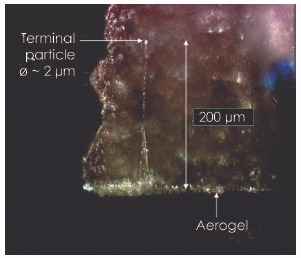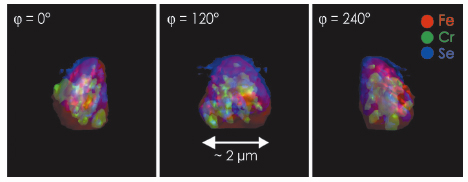- Home
- Users & Science
- Scientific Documentation
- ESRF Highlights
- ESRF Highlights 2009
- X-ray imaging
- 3D elemental imaging of cometary matter by nanoscale X-ray fluorescence tomography
3D elemental imaging of cometary matter by nanoscale X-ray fluorescence tomography
NASA’s Stardust spacecraft collected comet coma particles from the Comet 81P/Wild2 as well as interstellar grains and returned them to Earth [1]. The cometary micro-particles were captured using aerogel collectors, which contain a low-density silica-based solid with a porous, foam-like structure, about 1000 times less dense than glass. This low density minimises the deceleration particles experience upon impact with the aerogel. The spacecraft passed through the comet coma on the 2nd of January 2004. Particles impacted on the aerogel collector with a relative speed of approximately 6.1 km/s, leaving carrot or bulbous shaped impact tracks in the aerogel (Figure 138).
 |
|
Fig. 138: Stardust Track No.C2044,0,37 in the aerogel and the cometary grain analysed in this study. |
The uniqueness of these extraterrestrial particles calls for in situ (i.e. particle still enclosed in the aerogel matrix) and non-destructive analysis. Imaging of major, minor and trace elements within various absorbing matrices is possible using µ-XRF (X-ray fluorescence). Simple linear µ-XRF scanning of the sample along a vertical and horizontal raster through the µ-beam results in integrated two-dimensional (2D) projections of the elemental distributions within the sample. However, these projections do not contain depth information, as the complete intersection of the beam with the sample is measured. This depth information can be reconstructed with µ-XRF tomography.
The fully three-dimensional (3D) distribution of main and trace elements from within the terminal particle was determined based on sub-micrometre XRF tomography at a spatial resolution level of 200 nm. This experiment was performed at beamline ID13, using an excitation energy of 12.7 keV. An essentially symmetric sub-micrometre X-ray beam of 220 x 170 nm2 (HxV) (4–5x109ph/s) was obtained using a crossed linear Fresnel lens system provided by C. David [2]. Full 2D nano-XRF images for each tomographic view (pixel size: 100 nm) were collected, taking approximately 48 hours of measuring time. The reconstruction of the 3D elemental distributions was performed using a voxel size of 100 nm. An RGB composite image of the low intensity isosurface distributions of Fe (red), Cr (green) and Se (blue) for different angular views is given in Figure 139.
 |
|
Fig. 139: Reconstructed low intensity isosurface composite images for different azimuthal viewing angles. |
The inhomogeneous distribution of elements in the terminal particle helps to understand the nature of the studied material and to distinguish between artificial elemental concentrations and that of the chemistry of the captured cometary particle [1]. During the preliminary examination phase, it was shown that some elements, such as Cu, Zn and Ga show substantial enrichment over chondritic composition [1]. The observed Se-concentrations show the largest variation of hot spot analyses documented by Flynn et al. [1].
Both increased values over chondritic composition and the variable elemental concentrations from hotspot analyses could be explained by the observed 3-dimensional distribution of elements. The terminal particle studied in this work shows a Se-enrichment surrounding the top of the grain which is a clear indication for compressed aerogel in front of the impacted cometary dust particle. It can be clearly seen that the Se distribution forms a shell around the particle which does not originate from the particle itself. XRF measurements on the aerogel collectors used to capture the particles revealed the presence of trace levels of Se, which represents the most likely origin of the Se-lines within the measured nano-XRF spectra. The Se-rich external layer surrounding the particle is attributed to the partial melting and subsequent solidification of the aerogel around the terminal particle, as a result of the high speed impact of the comet coma particle.
The plate-like three dimensional distributions of Cr and Fe in the terminal grain resembles the structure of cryptocrystalline olivine-pyroxene chondrules. This interpretation is further supported by recent findings of chondrule-like objects in Wild-2 [3], which is a further strong argument for large scale mixing within the protoplanetary disc.
As demonstrated by the above example on this unique cometary material, the sub-microscopic three-dimensional reconstruction of trace-level elemental distributions within this 2 µm individual particle not only reveals the heterogeneous nature of the cometary grain, but also enables elemental constituents originally present in the cometary matter to be distinguished from those present as impurities within the embedding aerogel host matrix.
References
[1] G.J. Flynn et al. Science 314, 1731 (2006).
[2] B. Nöhammer, C. David, M. Burghammer and C. Riekel, Applied Physics Letters, 86, 163104 (2005).
[3] T. Nakamura, T. Noguchi, A. Tsuchiyama, T. Ushikubo, N.T. Kita, J.W. Valley, M.E. Zolensky, Y. Kakazu, K. Sakamoto, E. Mashio, K. Uesugi and T. Nakano, Science 321, 1664 – 1667 (2008).
Principal publication and authors
G. Silversmit (a), B. Vekemans (a), F.E. Brenker (b), S. Schmitz (b), M. Burghammer (c), C. Riekel (c) and L. Vincze (a), Analytical Chemistry, 81, 6107 (2009).
(a) X-ray Microspectroscopy and Imaging (XMI) group, Department of Analytical Chemistry, Ghent University (Belgium)
(b) GeoScience Institute, Goethe University, Frankfurt (Germany)
(c) ESRF



